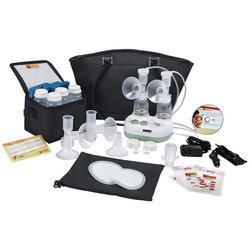Working and Breastfeeding
Work is the reason why many women cannot breastfeed their children as much as they would like to. Earlier, it was men who provided for the household, giving lactating mothers plenty of time to nurse their babies. Combined with a women's liberation movement in the late 1960s that demanded a greater role for women in all spheres of life, breastfeeding went out of vogue in the 1970s. The data supports this - in 2014, 57% of women with babies were active participants in the workforce, according to the Bureau of Labor Statistics. Ten years ago, it was only 54%. Changing social milieu, such as single mothers who need to provide for themselves and their babies, and therefore cannot afford to take time off work, may have also contributed towards this.
Unfortunately, there is also another troubling statistic – more than a third (42% to be exact, according to the National Institute of Health) of Americans are obese. Breast milk has been shown to protect children from being obese (this extends well into their adulthood and lasts all throughout their life). But the percentage of mothers who breastfeed their babies exclusively for the first six months – which is recommended by the medical community is a mere 16.4%.
Formula: It is recommended that you breastfeed your baby for 6 months before introducing formula.
So what is the solution? Thanks to advances in medical technology, there are now breast pumps capable of extracting milk from your breasts. You could feed breast milk to your baby later using a baby bottle. These pumps can now also be purchased through insurance, so you do not have to worry about how much they cost.
You can pump your milk while at home or in the office - if you work at a company that has more than 50 employees, federal laws state that your employer needs to provide you with a safe, clean place to pump. Using a double breast pump gets the job done in half the time, so you can get back to work faster.
How much should you pump?
You can pump during breaks (expect to put aside some 30 minutes for a pump). Also, keep in mind that what you get during a single pump might be only half of your child's intake during a feeding session, so the rule of thumb is that two pumping sessions should generate enough for a single feeding session. But then again, this too varies across lactating women.
At home, you need to pump between feeding sessions. You can store the pumped milk in the refrigerator, either at home or the office - there are special containers that can be used for this purpose.
So for now, you can focus on both your career and your baby.
Article Reviewed By Crystal Ibetoh MD, MBA reviews each article and ensures the accuracy of the health information. Dr. Ibetoh has strong medical interests in women's health and preventative medicine. She is also a mother of three and uses her medical expertise in addition to personal experience to provide advice about breastfeeding.
*The information provided on this site is intended for your general knowledge only and is not a substitute for professional medical advice or treatment. Please consult your healthcare provider with any questions or concerns you may have regarding breastfeeding.*

Both mother and child can reap numerous benefits from exclusive breastfeeding for the initial six months... Read More

Isn’t it everyone’s dream to burn all those calories while sitting comfortably on their lounge chair... Read More
